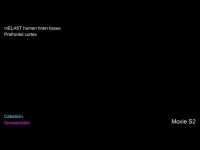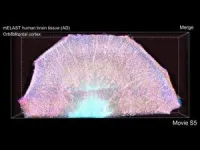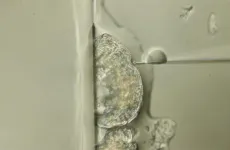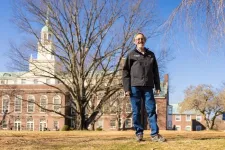(Press-News.org) Observing anything and everything within the human brain, no matter how large or small while it is fully intact, has been an out-of-reach dream of neuroscience for decades, but in a new study in Science, an MIT-based team describes a technology pipeline that enabled them to finely process, richly label and sharply image full hemispheres of the brains of two donors—one with Alzheimer’s and one without—at high resolution and speed.
“We performed holistic imaging of human brain tissues at multiple resolutions from single synapses to whole brain hemispheres and we have made that data available,” said senior and corresponding author Kwanghun Chung, associate professor in The Picower Institute for Learning and Memory, the Departments of Chemical Engineering and Brain and Cognitive Sciences, and the Institute for Medical Engineering and Science at MIT. “This technology pipeline really enables us to analyze the human brain at multiple scales. Potentially this pipeline can be used for fully mapping human brains.”
The new study does not already present a comprehensive map or atlas of the entire brain, in which every cell, circuit and protein is identified and analyzed, but with full hemispheric imaging, it demonstrates an integrated suite of three technologies to enable that and other long-sought neuroscience investigations. The research provides a “proof of concept” by showing numerous examples of what the pipeline makes possible, including sweeping landscapes of thousands of neurons within whole brain regions, diverse forests of cells each in individual detail, and tufts of subcellular structures nestled among extracellular molecules. The researchers also present a rich variety of quantitative analytical comparisons focused on a chosen region within the Alzheimer’s and non-Alzheimer’s hemispheres.
The importance of being able to image whole hemispheres of human brains intact and down to the resolution of individual synapses (the teeny connections that neurons forge to make circuits) is two-fold for understanding the human brain in health and disease, Chung said.
On one hand, it will enable scientists to conduct integrated explorations of questions using the same brain, rather than having to, for example, observe different phenomena in different brains, which can vary significantly, and then trying to construct a composite picture of the whole system. A key feature of the new technology pipeline is that analysis doesn’t degrade the tissue. On the contrary, it makes the tissues extremely durable and repeatedly re-labelable to highlight different cells or molecules as needed for new studies for potentially years on end. In the paper Chung’s team demonstrates using 20 different antibody labels to highlight different cells and proteins but they are already expanding that to a hundred or more.
“We need to be able to see all these different functional components—cells, their morphology and their connectivity, subcellular architectures, and their individual synaptic connections—ideally within the same brain, considering the high individual variabilities in the human brain and considering the precious nature of human brain samples,” Chung said. “This technology pipeline really enables us to extract all these important features from the same brain in a fully integrated manner.”
On the other hand, the pipeline’s relatively high scalability and throughput (imaging a whole brain hemisphere once it is prepared takes 100 hours rather than many months) means that it is possible to create many samples to represent different sexes, ages, disease states and other factors that can enable robust comparisons with increased statistical power. Chung said he envisions creating a brain bank of fully imaged brains that researchers could analyze and re-label as needed for new studies to make more of the kinds of comparisons he and co-authors made with the Alzheimer’s and non-Alzheimer’s hemispheres in the new paper.
Three key innovations
Chung said the biggest challenge he faced in achieving the advances described in the paper was building a team at MIT that included three especially talented young scientists, each a co-lead author of the paper because of their key roles in producing the three major innovations. Ji Wang, a mechanical engineer and former postdoc, developed the “Megatome,” a device for slicing intact human brain hemispheres so finely that there is no damage to it. Juhyuk Park, a materials engineer and former postdoc, developed the chemistry that makes each brain slice clear, flexible, durable, expandable, and quickly, evenly and repeatedly labelable—a technology called “mELAST.” Webster Guan, a former MIT chemical engineering graduate student with a knack for software development, created a computational system called “UNSLICE” that can seamlessly reunify the slabs to reconstruct each hemisphere in full 3D down to the precise alignment of individual blood vessels and neural axons (the long strands they extend to forge connections with other neurons).
No technology allows for imaging whole human brain anatomy at subcellular resolution without first slicing it because it is very thick (it’s 3,000 times the volume of a mouse brain) and opaque. But in the Megatome, tissue remains undamaged because Wang, who is now at a company Chung founded called LifeCanvas Technologies, engineered its blade to vibrate side to side faster and yet sweep wider than previous vibratome slicers. Meanwhile she also crafted the instrument to stay perfectly within its plane, Chung said. The result are slices that don’t lose anatomical information at their separation or anywhere else. And because the vibratome cuts relatively quickly and can cut thicker (and therefore fewer) slabs of tissue, a whole hemisphere can be sliced in a day, rather than months.
A major reason why slabs in the pipeline can be thicker comes from mELAST. Park engineered the hydrogel that infuses the brain sample to make it optically clear, virtually indestructible and compressible and expandable. Combined with other chemical engineering technologies developed in recent years in Chung’s lab, the samples can then be evenly and quickly infused with the antibody labels that highlight cells and proteins of interest. Using a light sheet microscope the lab customized, a whole hemisphere can be imaged down to individual synapses in about 100 hours, the authors report in the study. Park is now an assistant professor at Seoul National University in South Korea. “This advanced polymeric network, which fine-tunes the physicochemical properties of tissues, enabled multiplexed multiscale imaging of the intact human brains,” Park said.
After each slab has been imaged, the task is then to restore an intact picture of the whole hemisphere computationally. Guan’s UNSLICE does this at multiple scales. For instance, at the middle, or “meso” scale, it algorithmically traces blood vessels coming into one layer from adjacent layers and matches them. But it also takes an even finer approach. To further register the slabs, the team purposely labeled neighboring neural axons in different colors (like the wires in an electrical fixture). That enabled UNSLICE to match layers up based on tracing the axons, Chung said. Guan is also now at LifeCanvas.
In the study the researchers present a litany of examples of what the pipeline can do. The very first figure demonstrates that the imaging allows one to richly label a whole hemisphere and then zoom in from the wide scale of brainwide structures to the level of circuits, then individual cells and then subcellular components such as synapses. Other images and videos demonstrate how diverse the labeling can be, revealing long axonal connections and the abundance and shape of different cell types including not only neurons but also astrocytes and microglia.
Exploring Alzheimer’s
For years Chung has collaborated with co-author Matthew Frosch, an Alzheimer’s researcher and director of the brain bank at Massachusetts General Hospital, to image and understand Alzheimer’s disease brains. With the new pipeline established they began an open-ended exploration, first noticing where within a slab of tissue they saw the greatest loss of neurons in the disease sample compared to the control. From there, they followed their curiosity—as the technology allowed them to do—ultimately producing a series of detailed investigations described in the paper.
“We didn’t lay out all these experiments in advance,” Chung said. “We just started by saying, ‘OK, let’s image this slab and see what we see.’ We identified brain regions with substantial neuronal loss so let’s see what’s happening there. ‘Let’s dive deeper.’ So we used many different markers to characterize and see the relationships between pathogenic factors and different cell types.
“This pipeline allows us to have almost unlimited access to the tissue,” Chung said. “We can always go back and look at something new.”
They focused most of their analysis in the orbitofrontal cortex within each hemisphere. One of the many observations they made was that synapse loss was concentrated in areas where there was direct overlap with amyloid plaques. Outside of areas of plaques the synapse density was as high in the brain with Alzheimer’s as in the one without the disease.
With just two samples, Chung said, the team is not offering any conclusions about the nature of Alzheimer’s disease, of course, but the point of the study is that the capability now exists to fully image and deeply analyze whole human brain hemispheres to enable exactly that kind of research.
Notably, the technology applies equally well to many other tissues in the body, not just brains.
“We envision that this scalable technology platform will advance our understanding of the human organ functions and disease mechanisms to spur development of new therapies,” the authors conclude.
In addition to Park, Wang, Guan, Chung and Frosch, the paper’s other authors are Lars A. Gjesteby, Dylan Pollack, Lee Kamentsky, Nicholas B. Evans, Jeff Stirman, Xinyi Gu, Chuanxi Zhao, Slayton Marx, Minyoung E. Kim, Seo Woo Choi, Michael Snyder, David Chavez, Clover Su-Arcaro, Yuxuan Tian, Chang Sin Park, Qiangge Zhang, Dae Hee Yun, Mira Moukheiber, Guoping Feng, X. William Yang, C. Dirk Keene, Patrick R. Hof, Satrajit S. Ghosh, and Laura J. Brattain.
The main funding for the work came from the National Institutes of Health, The Picower Institute for Learning and Memory, The JPB Foundation, and the NCSOFT Cultural Foundation.
END
Technologies enable 3D imaging of whole human brain hemispheres at subcellular resolution
A suite of three innovations by an MIT-based team enables high-resolution, high-throughput imaging of human brain tissue at a full range of scales and mapping connectivity of neurons at single cell resolution.
2024-06-13
ELSE PRESS RELEASES FROM THIS DATE:
Modifying genomes of tardigrades to unravel their secrets
2024-06-13
Some species of tardigrades are highly and unusually resilient to various extreme conditions fatal to most other forms of life. The genetic basis for these exceptional abilities remains elusive. For the first time, researchers from the University of Tokyo successfully edited genes using the CRISPR technique in a highly resilient tardigrade species previously impossible to study with genome-editing tools. The successful delivery of CRISPR to an asexual tardigrade species directly produces gene-edited offspring. The design and ...
The yuck factor counteracts sustainable laundry habits
2024-06-13
Most people today would lean towards environmentally friendly life choices, but not at the expense of being clean. When it comes to our washing habits, the fear of being perceived as dirty often wins out over the desire to act in an environmentally friendly way. And the more inclined we are to feel disgusted, the more we wash our clothes. This is shown by a unique study from Chalmers University of Technology, Sweden, that examines the driving forces behind our laundering behaviours and provides new tools for how people's environmental impact can be reduced.
Today, we wash our clothes more than ever ...
Scientists unravel drivers of the global Zinc cycle in our oceans, with implications for a changing climate
2024-06-13
The important role of the Southern Ocean in global biological processes and the carbon cycle has been confirmed anew by a study published in Science this week that, for the first time based on field evidence, reveals the underappreciated role of inorganic Zinc particles in these cycles.
The Southern Ocean plays the greatest role in global phytoplankton productivity, which is responsible for absorbing atmospheric carbon dioxide. In these processes, Zinc, present in trace quantities in seawater, is an essential micronutrient critical to many biochemical processes in marine organisms and particularly for polar phytoplankton ...
Dopamine linked to mentalising abilities
2024-06-13
A link between the neurotransmitter dopamine and the mentalising abilities of healthy people has been identified for the first time in a new study.
Mentalising describes the act of attributing and understanding mental states (such as thoughts, feelings or intentions) in other people and in oneself. Researchers at the University of Birmingham have been able to show that changing people’s brain dopamine levels affects their mentalising abilities. Their results are published today in PLOS Biology.
Dopamine ...
The scary, yet promising world of phages, the pathogen's pathogen
2024-06-13
Bacteriophages, viruses that attack and destroy bacteria, are everywhere in the natural world where they play a vital role in regulating microbe populations in ways that are not yet well understood.
New research led by the University of Utah and University College London (UCL) has found that plant bacterial pathogens are able to repurpose elements of their own bacteriophages, or phages, to wipe out competing microbes. These surprise findings suggest such phage-derived elements could someday be harnessed as an alternative to antibiotics, according to Talia Karasov, an assistant professor in the U’s School of ...
Rising carbon dioxide may be diluting plant nutrients, threatening herbivores
2024-06-13
Smithsonian Conservation Research Brief:
Carbon dioxide-fueled accelerated plant growth dilutes nutrients, impacting herbivore populations.
A new study from researchers at the Smithsonian’s National Zoo and Conservation Biology Institute (NZCBI) warns that as human activities increase carbon dioxide (CO2) levels in the atmosphere, they may decrease the nutrient contents of plants. Declines in nutrient content, known as Nutrient Dilution, may already be harming plant-eating animals and could cause further population declines farther up the ecological chain. The paper, published today in the journal Trends ...
Avi Wigderson to deliver Turing Lecture at ACM Symposium on Theory of Computing
2024-06-13
ACM, the Association for Computing Machinery, is pleased to announce that 2023 ACM A.M. Turing Award recipient Avi Wigderson will give his Turing Lecture at the 2024 ACM Symposium on the Theory of Computing (STOC) on Thursday, June 27 in Vancouver, British Columbia, Canada. Wigderson received the A.M. Turing Award for foundational contributions to the theory of computation, including reshaping our understanding of the role of randomness in computation, and for his decades of intellectual leadership in theoretical computer science.
In "Alan Turing: A TCS Role Model," Wigderson ...
Researchers to develop predictive model for opioid addiction in high-risk patients
2024-06-13
Opioids are a broad group of effective pain-relieving medicines that can become highly addictive in some individuals. According to government sources, nearly 40 million people are addicted to illicit drugs worldwide. In 2017, the U.S. Department of Health and Human Services declared the opioid crisis a national public health emergency. To combat the opioid epidemic, researchers at University of California San Diego School of Medicine will develop an AI model that will more accurately predict opioid addiction in high-risk patients.
The project is funded through a three-year contract with Wellcome Leap as part of a $50 million groundbreaking initiative, called ...
ADHD meds may help pregnant patients control opioid use disorder
2024-06-13
Opioid overdoses for pregnant patients are at an all-time high in the United States, even as overall numbers are improving. Attention deficit hyperactivity disorder (ADHD) is highly correlated with substance use disorders, yet treatment protocols to help expecting parents manage opioid use disorders and ADHD together are essentially nonexistent.
New research from Washington University School of Medicine in St. Louis may help change that. A study published in Nature Mental Health indicates that patients with opioid use disorders and ADHD who remain on their ADHD medications during their pregnancies are far more likely to adhere to treatment for opioid use, and far less likely to ...
Watery planets orbiting dead stars may be good candidates for studying life — if they can survive long enough
2024-06-13
The small footprint and dim light of white dwarfs, remnants of stars that have burned through their fuel, may make excellent backdrops for studying planets with enough water to harbor life.
The trick is spotting the shadow of a planet against a former star that has withered to a fraction of its size and finding that it’s a planet that has kept its water oceans for billions of years even after riding out the star’s explosive and violent final throes. A new study of the dynamics of white dwarf systems suggests that, in theory, some watery planets may indeed thread the celestial needles necessary to await ...
LAST 30 PRESS RELEASES:
Scientists to ‘spy’ on cancer- immune cell interactions using quantum technology breakthrough
Tech savvy users have most digital concerns
Making lighter work of calculating fluid and heat flow
Normalizing blood sugar can halve heart attack risk
Lowering blood sugar cuts heart attack risk in people with prediabetes
Study links genetic variants to risk of blinding eye disease in premature infants
Non-opioid ‘pain sponge’ therapy halts cartilage degeneration and relieves chronic pain
AI can pick up cultural values by mimicking how kids learn
China’s ecological redlines offer fast track to 30 x 30 global conservation goal
Invisible indoor threats: emerging household contaminants and their growing risks to human health
Adding antibody treatment to chemo boosts outcomes for children with rare cancer
Germline pathogenic variants among women without a history of breast cancer
Tanning beds triple melanoma risk, potentially causing broad DNA damage
Unique bond identified as key to viral infection speed
Indoor tanning makes youthful skin much older on a genetic level
Mouse model sheds new light on the causes and potential solutions to human GI problems linked to muscular dystrophy
The Journal of Nuclear Medicine ahead-of-print tip sheet: December 12, 2025
Smarter tools for peering into the microscopic world
Applications open for funding to conduct research in the Kinsey Institute archives
Global measure underestimates the severity of food insecurity
Child survivors of critical illness are missing out on timely follow up care
Risk-based vs annual breast cancer screening / the WISDOM randomized clinical trial
University of Toronto launches Electric Vehicle Innovation Ontario to accelerate advanced EV technologies and build Canada’s innovation advantage
Early relapse predicts poor outcomes in aggressive blood cancer
American College of Lifestyle Medicine applauds two CMS models aligned with lifestyle medicine practice and reimbursement
Clinical trial finds cannabis use not a barrier to quitting nicotine vaping
Supplemental nutrition assistance program policies and food insecurity
Switching immune cells to “night mode” could limit damage after a heart attack, study suggests
URI-based Global RIghts Project report spotlights continued troubling trends in worldwide inhumane treatment
Neutrophils are less aggressive at night, explaining why nighttime heart attacks cause less damage than daytime events
[Press-News.org] Technologies enable 3D imaging of whole human brain hemispheres at subcellular resolutionA suite of three innovations by an MIT-based team enables high-resolution, high-throughput imaging of human brain tissue at a full range of scales and mapping connectivity of neurons at single cell resolution.






